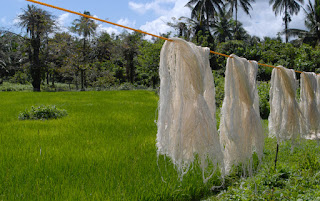Introduction
Dutch designer Aniela Hoitink has made a revolutionary garment using pure mycelium, which is the vegetation part of a mushroom fungus.
Material and Techniques
"Mycelium has been predominantly used in a solid state in combination with a substrate."(Mail Online, 2016) However, Aniela developed texitiles consisting only mycelium after researching. Taking inspiration of the 'soft bodies' species that grow themselves repeatedly and follows some kings of modular pattern, Aniela built her textiles in module system. "The discs of mushroom stick to each other to form a fabric, allowing Aniela to shape a dress on a mannequin without any sewing."(Mail Online, 2016) It also allows all the material potentially to be used, without any leftover during the making process.. One big advantage of modules is that it could be easily assembled and disassemble. In such way, the garment could be easily repaired without interfering the look of the fabric, by simply adding a new patch to cover the broken part. It becomes a living product. "'The garment can be built three-dimensionally and shaped whilst being made, fitting the wearer's wishes,' said Hoitink. 'Thus, it is possible to create mycelium patterns, to adjust the length of the garment or for example to add elements'."(Morby, 2016) The material is also biodegradable. It could be left in the ground without creating any waste
Analysis
Textile is usually been regarded as a static object and the consistency is what we pursue. Nowadays, consumption rate is keeping increasing. Clothes are disposable and hardly be repaired if broken. The garments made from mycelium is a slow project in the fast mass production industry. "The Petri dishes have to be left for a week-and-a-half to allow them to grow and Aniela needed 350 discs to make one dress."(Mail Online, 2016) Although it is not efficient compared to other material, I think it is an advantage as the time need for growing adds liveness subtleness to the material and make the garments more cherishable. Aniela wanted to change the way we use textile and I think it is successful.
Morby, A. (2016). Aniela Hoitink creates dress from mushroom mycelium. [online] Dezeen. Available at: https://www.dezeen.com/2016/04/01/aniela-hoitink-neffa-dress-mushroom-mycelium-textile-materials-fashion/ [Accessed 23 Dec. 2016].
Mail Online. (2016). Designer creates dress from MUSHROOM ROOT. [online] Available at: http://www.dailymail.co.uk/femail/article-3561205/Is-FUNGUS-future-fashion-Designer-grows-eco-friendly-dress-mushroom-root-just-one-week.html [Accessed 22 Dec. 2016].























